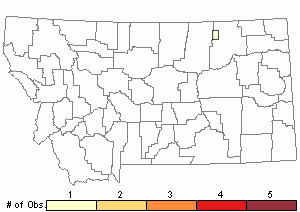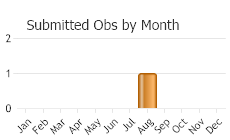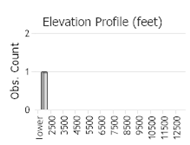View in other NatureServe Network Field Guides
NatureServe
Montana
Utah
Wyoming
Idaho
Wisconsin
British Columbia
South Carolina
Yukon
California
New York
Mormon Metalmark - Apodemia mormo
General Description
[From Ferris and Brown 1981; Scott 1986; Opler and Wright 1999; Glassberg 2001; Pyle 2002] Forewing length 1.3-1.6 cm. Wings short and broad. Sexes similar. Fringes white with black checks at vein endings. Uppersurface of forewing dark-brown to black with white spot bands, red-orange to yellow-orange (russet) basally; white spot in forewing cell sometimes covered with red-orange scaling (subspecies langei; hindwing black with small white spots (subspecies mormo and langei) or with areas of red-orange or orange (subspecies cythera) or yellow to yellow-orange (subspecies tuolumnensis). Undersurface of forewing russet basally, brown marginally with gray pointers; hindwing silvery-gray, mottled with large white spots, no metallic marks.
Phenology
One flight, mainly August ; several flights in the south, March to early October (rarely January to December)(Scott 1986). Single brood areas , April to June or August to November; two brood areas March to April and August to October (Glassberg 2001). July to September in the Rocky Mountain states (Ferris and Brown 1981). Early July to late August in Colorado (Scott and Scott 1978), mid-August to late September in North Dakota (McCabe and Post 1976), August in Saskatchewan (Wick et al. 2012, 2014; Wick 2013), early February to mid November in southern Nevada (Austin and Austin 1980), early August to early October in Oregon and Washington (Pyle 2002), late July to early October in Oregon (Warren 2005), mid-August to late September in British Columbia (Guppy and Shepard 2001).
Diagnostic Characteristics
Best determined by a combination of size and distinctive combination of black and orange with many white spots, undersurface of hindwing silvery gray with large white spots in the basal 2/3.
Species Range
Montana Range
Range Descriptions

 Native
Native
Range Comments
Extreme southern British Columbia south through Baja California, east across the southwest, Great Basin, and southern Idaho to southern Wyoming and central Colorado south to western Texas and northern Mexico; also south-central Saskatchewan, eastern Montana, western North Dakota (Scott 1986; Opler and Wright 1999; Glassberg 2001); 1830 m to 2440 m elevation in the Rocky Mountain states (Ferris and Brown 1981), 1524 m to 3048 m elevation in Colorado (Brown 1957; Scott and Scott 1978), to at least 2134 m elevation in Wyoming (Nabakov 1952), to at least 847 m in Saskatchewan (Wick 2013; Wick et al. 2014), 46 m to 2024 m elevation in Oregon (Warren 2005). In Montana, reported from at least 20 counties, mostly in the eastern 1/2 of the state, west to Jefferson County (Kohler 1980; Stanford and Opler 1993; Proshek et al. 2013; FLMNH Lepidopterists' Society database), to at least 1615 m elevation. Individuals from Montana more closely related to those from Saskatchewan than populations farther west in British Columbia and the Pacific Northwest US (Proshek et al. 2013). Locally rare to locally common (mainly locally uncomon) (Glassberg 2001).
Observations in Montana Natural Heritage Program Database
Number of Observations: 1
(Click on the following maps and charts to see full sized version)
Map Help and Descriptions
Relative Density

Recency



 (Observations spanning multiple months or years are excluded from time charts)
(Observations spanning multiple months or years are excluded from time charts)
Migration
Non-migratory. Maximum movement mostly < 500 m: average 49 m for males, 64 m for females (Scott 1986).
Habitat
Grasslands, chaparral, open woodlands, badlands, dunes, roadsides, desert washes, dry hillsides, rocky slopes, sagebrush flats (Nabakov 1952; McCabe and Post 1976; Austin and Austin 1980; Ferris and Brown 1981; Scott 1986; Opler and Wright 1999; Pyle 2002); in Saskatchewan, local sites with higher percentage of bare ground on slopes with S-SW exposures where associated with host plant (Wick 2013; Wick et al. 2014). Habitat in Montana not described but probably similar.
Food Habits
Larval host plants are various buckwheats (Polygonaceae), and include at least 20 species of
Eriogonum including
E. pauciflorum (syn.
E. multiceps) in Saskatchewan; also
Krameria (Krameriaceae) in Texas (Emmel et al. 1970; Austin and Austin 1980; Ferris and Brown 1981; Scott 1986, 1992, 2006; Guppy and Shepard 2001; Warren 2005; James and Nunnallee 2011). Adults feed on flower nectar, including
Acamptopappus,
Anaphalis,
Bassaris,
Baileya,
Bebbia,
Ceanothus,
Chaenactis,
Cirsium,
Clematis,
Cryptantha,
Ericameria (=
Chrysothamnus),
Eriogonum,
Heterotheca,
Monardella,
Palafoxia,
Senecio,
Solidago,
Sphaeralcea,
Stephanomeria, and
Tetradymia (Austin and Austin 1980; Pyle 2002; Wick et al. 2012; Scott 2014).
Reproductive Characteristics
Adult lifespan about 9-11 days. Females lay eggs singly or in small clusters of 2-4 on host plant leaves (both surfaces), flowers, stems, nearby inert surfaces in soil cracks or under small rocks (Scott 1986, 2006; James and Nunnallee 2011; Wicks et al. 2012; Wicks 2013). Eggs develop for about 30 days, diapause and overwinter, hatch in 4-10 days in spring after exiting diapause. Larval development slow, molt to L2 instar in 7 days (depending on temperature), develop from L3 instar to L6 instar in another 40-45 days; sometimes pupate as L4 or L5 instar (James and Nunnallee 2011). Larvae feed on host plant leaves and stems, live in nest of leaves tied with silk, feed at night (sometimes in the day), mid-aged larvae reported to enter diapause in inflated stems, dried flower heads, usually under litter (Scott 1979, 1986); larvae sometimes attended by the ant Formica pilicornis (Ballmer and Pratt 1991). Males perch mostly in depressions and gullies on hillsides during midday, awaiting passing females, which they then pursue (Scott 1975b, 1986).
Management
Habitat restoration, cultivation of the host plant, and captive breeding of the butterfly may be necessary. For subspecies langei control of invasive weedy alien plants by means other than fire is an imperative.
Stewardship Responsibility
References
- Literature Cited AboveLegend:
 View Online Publication
View Online Publication Austin, G.T. and A.T. Austin. 1980. Butterflies of Clark County, Nevada. Journal of Research on the Lepidoptera 19:1-63.
Austin, G.T. and A.T. Austin. 1980. Butterflies of Clark County, Nevada. Journal of Research on the Lepidoptera 19:1-63. Ballmer, G.R. and G.F. Pratt. 1991. Quantification of ant attendance (myrmecophily) of lycaenid larvae. Journal of Research on the Lepidoptera 30(1-2): 95-112.
Ballmer, G.R. and G.F. Pratt. 1991. Quantification of ant attendance (myrmecophily) of lycaenid larvae. Journal of Research on the Lepidoptera 30(1-2): 95-112. Brown, F.M. 1957. Colorado Butterflies. Proceedings; Numbers Three through Seven. Denver Museum of Natural History, Denver, Co.
Brown, F.M. 1957. Colorado Butterflies. Proceedings; Numbers Three through Seven. Denver Museum of Natural History, Denver, Co. Emmel, J.F., O. Shields, and D.E. Breedlove. 1970. Larval foodplant records for North American Rhopalocera Part 2. Journal of Research on the Lepidoptera 9(4): 233-242.
Emmel, J.F., O. Shields, and D.E. Breedlove. 1970. Larval foodplant records for North American Rhopalocera Part 2. Journal of Research on the Lepidoptera 9(4): 233-242. Ferris, C.D. and F.M. Brown (eds). 1981. Butterflies of the Rocky Mountains. Univ. of Oklahoma Press. Norman. 442 pp.
Ferris, C.D. and F.M. Brown (eds). 1981. Butterflies of the Rocky Mountains. Univ. of Oklahoma Press. Norman. 442 pp. Glassberg, J. 2001. Butterflies through Binoculars: A Field Guide to the Butterflies of Western North America. Oxford University Press.
Glassberg, J. 2001. Butterflies through Binoculars: A Field Guide to the Butterflies of Western North America. Oxford University Press. Guppy, C.S. and J.H. Shepard. 2001. Butterflies of British Columbia: including western Alberta, southern Yukon, the Alaska Panhandle, Washington, northern Oregon, northern Idaho, northwestern Montana. UBC Press (Vancouver, BC) and Royal British Columbia Museum (Victoria, BC). 414 pp.
Guppy, C.S. and J.H. Shepard. 2001. Butterflies of British Columbia: including western Alberta, southern Yukon, the Alaska Panhandle, Washington, northern Oregon, northern Idaho, northwestern Montana. UBC Press (Vancouver, BC) and Royal British Columbia Museum (Victoria, BC). 414 pp. James, D.G. and D. Nunnallee. 2011. Life histories of Cascadia butterflies. Corvallis, OR: Oregon State University Press. 447 p.
James, D.G. and D. Nunnallee. 2011. Life histories of Cascadia butterflies. Corvallis, OR: Oregon State University Press. 447 p. Kohler, S. 1980. Checklist of Montana Butterflies (Rhopalocera). Journal of the Lepidopterists' Society 34(1): 1-19.
Kohler, S. 1980. Checklist of Montana Butterflies (Rhopalocera). Journal of the Lepidopterists' Society 34(1): 1-19. McCabe, T.L. and R.L. Post. 1976. North Dakota butterfly calendar (including possible strays). Journal of Research on the Lepidoptera 15:93-99.
McCabe, T.L. and R.L. Post. 1976. North Dakota butterfly calendar (including possible strays). Journal of Research on the Lepidoptera 15:93-99. Nabokov, V. 1953. Butterfly collecting in Wyoming, 1952. The Lepidopterists' News 7(2): 49-52.
Nabokov, V. 1953. Butterfly collecting in Wyoming, 1952. The Lepidopterists' News 7(2): 49-52. Opler, P.A. and A.B. Wright. 1999. A field guide to western butterflies. Second edition. Peterson Field Guides. Houghton Mifflin Company, Boston, Massachusetts. 540 pp.
Opler, P.A. and A.B. Wright. 1999. A field guide to western butterflies. Second edition. Peterson Field Guides. Houghton Mifflin Company, Boston, Massachusetts. 540 pp. Proshek, B., L.A. Crawford, C.S. Davis, S. Desjardins, A.E. Henderson, and F.A.H. Sperling. 2013. Apodemia mormo in Canada: population genetic data support prior conservation ranking. Journal of Insect Conservation. 17:155-170.
Proshek, B., L.A. Crawford, C.S. Davis, S. Desjardins, A.E. Henderson, and F.A.H. Sperling. 2013. Apodemia mormo in Canada: population genetic data support prior conservation ranking. Journal of Insect Conservation. 17:155-170. Pyle, R.M. 2002. The butterflies of Cascadia: a field guide to all the species of Washington, Oregon, and surrounding territories. Seattle Audubon Society, Seattle, Washington. 420 pp.
Pyle, R.M. 2002. The butterflies of Cascadia: a field guide to all the species of Washington, Oregon, and surrounding territories. Seattle Audubon Society, Seattle, Washington. 420 pp. Scott, J.A. 1975b. Mate-locating behavior of western North American butterflies. Journal of Research on the Lepidoptera 14:1-40.
Scott, J.A. 1975b. Mate-locating behavior of western North American butterflies. Journal of Research on the Lepidoptera 14:1-40. Scott, J.A. 1979. Hibernal diapause of North American Papilionoidea and Hesperioidea. Journal of Research on the Lepidoptera 18(3): 171-200.
Scott, J.A. 1979. Hibernal diapause of North American Papilionoidea and Hesperioidea. Journal of Research on the Lepidoptera 18(3): 171-200. Scott, J.A. 1986. The butterflies of North America: a natural history and field guide. Stanford University Press, Stanford, California.
Scott, J.A. 1986. The butterflies of North America: a natural history and field guide. Stanford University Press, Stanford, California. Scott, J.A. 1992. Hostplant records for butterflies and skippers (mostly from Colorado) 1959-1992, with new life histories and notes on oviposition, immatures, and ecology. Papilio new series #6. 185 p.
Scott, J.A. 1992. Hostplant records for butterflies and skippers (mostly from Colorado) 1959-1992, with new life histories and notes on oviposition, immatures, and ecology. Papilio new series #6. 185 p. Scott, J.A. 2006. Butterfly hostplant records, 1992-2005, with a treatise on the evolution of Erynnis, and a note on new terminology for mate-locating behavior. Papilio new series #14. 74 p.
Scott, J.A. 2006. Butterfly hostplant records, 1992-2005, with a treatise on the evolution of Erynnis, and a note on new terminology for mate-locating behavior. Papilio new series #14. 74 p. Scott, J.A. 2014. Lepidoptera of North America 13. Flower visitation by Colorado butterflies (40,615 records) with a review of the literature on pollination of Colorado plants and butterfly attraction (Lepidoptera: Hersperioidea and Papilionoidea). Contributions of the C.P. Gillette Museum of Arthopod Diversity. Fort Collins, CO: Colorado State University. 190 p.
Scott, J.A. 2014. Lepidoptera of North America 13. Flower visitation by Colorado butterflies (40,615 records) with a review of the literature on pollination of Colorado plants and butterfly attraction (Lepidoptera: Hersperioidea and Papilionoidea). Contributions of the C.P. Gillette Museum of Arthopod Diversity. Fort Collins, CO: Colorado State University. 190 p. Scott, J.A. and G.R. Scott. 1978. Ecology and distribution of the butterflies of southern central Colorado. Journal of Research on the Lepidoptera 17(2): 73-128.
Scott, J.A. and G.R. Scott. 1978. Ecology and distribution of the butterflies of southern central Colorado. Journal of Research on the Lepidoptera 17(2): 73-128. Stanford, R.E. and P.A. Opler. 1993. Atlas of western USA butterflies: including adjacent parts of Canada and Mexico. Unpubl. Report. Denver and Fort Collins, Colorado 275 pp.
Stanford, R.E. and P.A. Opler. 1993. Atlas of western USA butterflies: including adjacent parts of Canada and Mexico. Unpubl. Report. Denver and Fort Collins, Colorado 275 pp. Warren, A.D. 2005. Lepidoptera of North America 6: Butterflies of Oregon, their taxonomy, distribution, and biology. Contributions of the C. P. Gillette Museum of Arthropod Diversity, Colorado State University. Fort Collins, Colorado. 406 pp.
Warren, A.D. 2005. Lepidoptera of North America 6: Butterflies of Oregon, their taxonomy, distribution, and biology. Contributions of the C. P. Gillette Museum of Arthropod Diversity, Colorado State University. Fort Collins, Colorado. 406 pp. Wick, A., and J. Jamelle, S. Pruss, and N. Erbilgin. 2012. First observations of Mormon Metalmark (Apodemia mormo) oviposition behavior in Canada. Canadian Field-Naturalist. 126:34-37.
Wick, A., and J. Jamelle, S. Pruss, and N. Erbilgin. 2012. First observations of Mormon Metalmark (Apodemia mormo) oviposition behavior in Canada. Canadian Field-Naturalist. 126:34-37. Wick, A., S. Pruss, J. Spence, and N. Erbilgin. 2014. Microhabitat use in a northern peripheral population of Apodemia mormo: factors beyond the host plant. Journal of the Lepidopterists Society. 68:54-60.
Wick, A., S. Pruss, J. Spence, and N. Erbilgin. 2014. Microhabitat use in a northern peripheral population of Apodemia mormo: factors beyond the host plant. Journal of the Lepidopterists Society. 68:54-60. Wick, Ashley Anne. 2013. Beyond the host plant: Multi-scale habitat models for a northern peripheral population of the butterfly, Apodemia mormo (Lepidoptera: Riodinidae). M.Sc. Thesis. University of Alberta. Edmonton, Alberta. 81p.
Wick, Ashley Anne. 2013. Beyond the host plant: Multi-scale habitat models for a northern peripheral population of the butterfly, Apodemia mormo (Lepidoptera: Riodinidae). M.Sc. Thesis. University of Alberta. Edmonton, Alberta. 81p.
- Additional ReferencesLegend:
 View Online Publication
View Online Publication
Do you know of a citation we're missing? Allen, T.J., J.P. Brock, and J. Glassberg. 2005. Caterpillars in the field and garden: a field guide to the butterfly caterpillars of North America. Oxford University Press.
Allen, T.J., J.P. Brock, and J. Glassberg. 2005. Caterpillars in the field and garden: a field guide to the butterfly caterpillars of North America. Oxford University Press. Brock, J.P. and K. Kaufman. 2003. Kaufman Field Guide to Butterflies of North America. Houghton Mifflin Company, New York, NY 284 pp.
Brock, J.P. and K. Kaufman. 2003. Kaufman Field Guide to Butterflies of North America. Houghton Mifflin Company, New York, NY 284 pp. Forister, M.L., C.A. Halsch, C.C. Nice, J.A. Fordyce, T.E. Dilts, J.C. Oliver, K.L. Prudic, A.M. Shapiro, J.K. Wilson, J. Glassberg. 2021. Fewer butterflies seen by community scientists across the warming and drying landscapes of the American West. Science 371:1042-1045.
Forister, M.L., C.A. Halsch, C.C. Nice, J.A. Fordyce, T.E. Dilts, J.C. Oliver, K.L. Prudic, A.M. Shapiro, J.K. Wilson, J. Glassberg. 2021. Fewer butterflies seen by community scientists across the warming and drying landscapes of the American West. Science 371:1042-1045. Forister, M.L., E.M. Grames, C.A. Halsch, K.J. Burls, C.F. Carroll, K.L. Bell, J.P. Jahner, et al. 2023. Assessing risk for butterflies in the context of climate change, demographic uncertainty, and heterogeneous data sources. Ecological Monographs 93(3):e1584. https://doi.org/10.1002/ecm.1584
Forister, M.L., E.M. Grames, C.A. Halsch, K.J. Burls, C.F. Carroll, K.L. Bell, J.P. Jahner, et al. 2023. Assessing risk for butterflies in the context of climate change, demographic uncertainty, and heterogeneous data sources. Ecological Monographs 93(3):e1584. https://doi.org/10.1002/ecm.1584 Layberry, R.A., P.W. Hall, and J.D. LaFontaine. 1998. The Butterflies of Canada. University of Toronto Press. 280 pp. + color plates.
Layberry, R.A., P.W. Hall, and J.D. LaFontaine. 1998. The Butterflies of Canada. University of Toronto Press. 280 pp. + color plates. Pruss, S., A. Henderson, P. Fargey, and J. Tuckwell. 2008. Recovery Strategy for the Mormon Metalmark (Apodemia Mormo) Prairie Population, in Canada. Species at Risk Act Recovery Strategy Series. Parks Canada Agency. Ottawa. 29 pp.
Pruss, S., A. Henderson, P. Fargey, and J. Tuckwell. 2008. Recovery Strategy for the Mormon Metalmark (Apodemia Mormo) Prairie Population, in Canada. Species at Risk Act Recovery Strategy Series. Parks Canada Agency. Ottawa. 29 pp.
- Web Search Engines for Articles on "Mormon Metalmark"
- Additional Sources of Information Related to "Insects"





